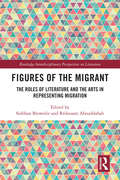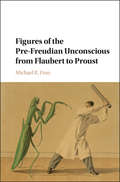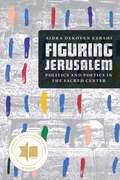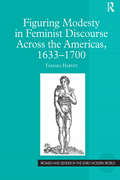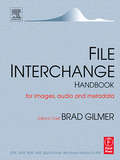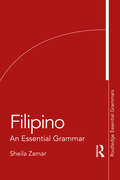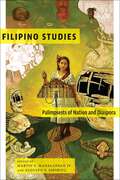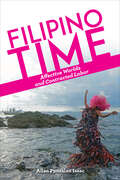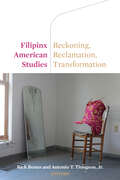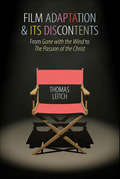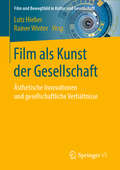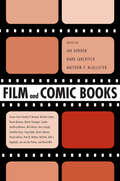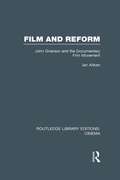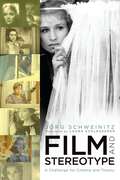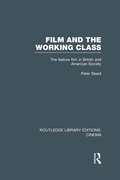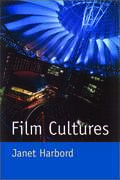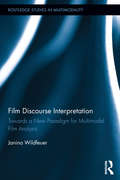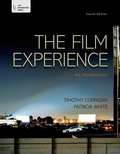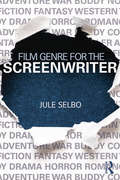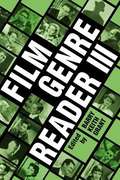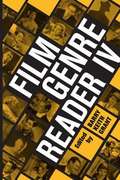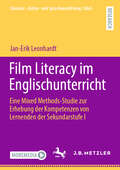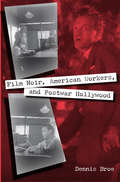- Table View
- List View
Figures of the Migrant: The Roles of Literature and the Arts in Representing Migration (Routledge Interdisciplinary Perspectives on Literature)
by Siobhan Brownlie and Rédouane AbouddahabThis volume seeks to investigate the representation of the migrant and migration in literary texts and the arts. Through studies that examine works in a range of art forms ‒ novels, theatre, poetry, creative non-fiction, documentary films, and performance and video installations ‒ that evoke a variety of historical and (trans)national contexts, the volume focuses on the question of the roles of literature and the arts in representing migration. An important issue considered is the extent to which artistic figuration can act as a counterpoint to social discourse on migrants that often involves stereotypes and reductive views. The different contributions to the volume illustrate that literature and the arts can provide readers and viewers with a space for fluid knowledge production and affective expansion, and that within that overarching function, artistic works play three main roles with regard to representing migration: undertaking a socio-political and cultural critique, presenting alternative views to stereotypes that highlight the singularity and complexity of the migrant, and providing proposals for different futures.
Figures of the Pre-Freudian Unconscious from Flaubert to Proust
by Michael R. FinnAn original, wide-ranging contribution to the study of French writing in the nineteenth and early twentieth centuries, this book examines the ways in which the unconscious was understood in literature in the years before Freud. Exploring the influence of medical and psychological discourse over the existence and/or potential nature of the unconscious, Michael Finn discusses the resistance of feminists opposing medical diagnoses of the female brain as the seat of the unconscious, the hypnotism craze of the 1880s and the fascination, in fiction, with dual personality and posthypnotic crimes. The heart of the study explores how the unconscious inserts itself into the writing practice of Flaubert, Maupassant and Proust. Through the presentation of scientific evidence and quarrels about the psyche Michael Finn is able to show the work of such writers in a completely new light.
Figuring Jerusalem: Politics and Poetics in the Sacred Center
by Sidra DeKoven EzrahiFiguring Jerusalem explores how Hebrew writers have imagined Jerusalem, both from the distance of exile and from within its sacred walls. For two thousand years, Hebrew writers used their exile from the Holy Land as a license for invention. The question at the heart of Figuring Jerusalem is this: how did these writers bring their imagination “home” in the Zionist century? Sidra DeKoven Ezrahi finds that the same diasporic conventions that Hebrew writers practiced in exile were maintained throughout the first half of the twentieth century. And even after 1948, when the state of Israel was founded but East Jerusalem and its holy sites remained under Arab control, Jerusalem continued to figure in the Hebrew imagination as mediated space. It was only in the aftermath of the Six Day War that the temptations and dilemmas of proximity to the sacred would become acute in every area of Hebrew politics and culture.Figuring Jerusalem ranges from classical texts, biblical and medieval, to the post-1967 writings of S. Y. Agnon and Yehuda Amichai. Ultimately, DeKoven Ezrahi shows that the wisdom Jews acquired through two thousand years of exile, as inscribed in their literary imagination, must be rediscovered if the diverse inhabitants of Jerusalem are to coexist.
Figuring Korean Futures: Children’s Literature in Modern Korea
by Dafna ZurThis book is the story of the emergence and development of writing for children in modern Korea. Starting in the 1920s, a narrator-adult voice began to speak directly to a child-reader. This child audience was perceived as unique because of a new concept: the child-heart, the perception that the child's body and mind were transparent and knowable, and that they rested on the threshold of culture. This privileged location enabled writers and illustrators, educators and psychologists, intellectual elite and laypersons to envision the child as a powerful antidote to the present and as an uplifting metaphor of colonial Korea's future. Reading children's periodicals against the political, educational, and psychological discourses of their time, Dafna Zur argues that the figure of the child was particularly favorable to the project of modernity and nation-building, as well as to the colonial and postcolonial projects of socialization and nationalization. She demonstrates the ways in which Korean children's literature builds on a trajectory that begins with the child as an organic part of nature, and ends, in the post-colonial era, with the child as the primary agent of control of nature. Figuring Korean Futures reveals the complex ways in which the figure of the child became a driving force of nostalgia that stood in for future aspirations for the individual, family, class, and nation.
Figuring Modesty in Feminist Discourse Across the Americas, 1633-1700 (Women and Gender in the Early Modern World)
by Tamara HarveyInventive in its approach and provocative in its analysis, this study offers fresh readings of the arguments and practices of four seventeenth-century Euro-American women: Anne Bradstreet, Anne Hutchinson, Sor Juana Inés de la Cruz, and Marie de l'Incarnation. Tamara Harvey here compares functionalist treatments of the body by these women, offering a new way to think of corporeality as a device in literary and religious expressions of modesty by women. In doing so, Harvey explores the engagement of these women in ongoing religious, political, scientific and social debates that would have been understood by the authors' contemporaries in both Europe and America.
Figuring the Feminine
by Jill RossFiguring the Feminine examines the female body as a means of articulating questions of literary authority and practice within the cultural spheres of the Iberian Peninsula (both Romance and Semitic) as well as in the larger Latinate literary culture. It demonstrates the centrality in medieval literary culture of the gendering of rhetorical and hermeneutical acts involved in the creation of texts and meaning, and the importance of the medieval Iberian textual tradition in this process, a complex multicultural tradition that is often overlooked in medieval literary scholarship. This study adopts an innovative methodology informed by current theories of the body and gender to approach Hispanic literature from a femininst perspective.Jill Ross offers new readings of medieval Hispanic texts (Latin, Castilian, and Hebrew) including Prudentius' Peristephanon, Gonzalo de Berceo's Milagros de Nuestra Señora, Shem Tov of Carrión's Battle Between the Pen and the Scissors, and several others. She highlights ways in which these texts contribute to the understanding of gender in medieval poetics and foreground questions of literary and cultural import. Figuring the Feminine argues that the bodies of women are crucial to the working out of such questions as the unsettling shift from orality to literacy, textual instability, cultural dissonance, and the resistance to cultural and religious hegemony.
File Interchange Handbook: For professional images, audio and metadata
by Brad GilmerThe authoritative work on file formats for global film and television!The FILE INTERCHANGE HANDBOOK is a must-have reference for every film and video professional moving to computer based production and distribution. It is the only book that gives a complete scrutiny and breakdown of all file formats for the transfer of images, sound and metadata. Geared to a global audience, this text will get you the information that you need to learn this brand-new technology. Upcoming industry trends are mapped out alongside technology standards in this complete guide.Learn the purpose, functionality, and structure of each standard format with this single major reference on file interchange. This handbook is the one-stop resource you want for this essential technology.Table of contents:Intro--Brad Gilmer, Gilmer & Associates, Inc. 1. History / background--Hans Hoffman, EBU 2. Metadata dictionary--Oliver Morgan, Metaglue Corporation 3. Digital Picture eXchange (DPX)--Dave Bancroft, Thomson 4. General eXchange Format (GXF)--Bob Edge and Ray Baldock, Thomson Grass Valley 5. Material eXchange Format (MXF)--Jim Wilkinson, Sony, and Bruce Devlin, Snell & Wilcox, Ltd 6. Advanced Authoring Format (AAF)--Phil Tudor, BBC 7. Windows Media 9-Advanced System Format (ASF)--Nick Vicars-Harris, Microsoft Corporation 8. Apple QuickTime--George Towner, Apple Computer, Inc.Praise for the File Interchange Handbook:"Brad Gilmer has assembled a timely and valuable reference work covering the technical and structural aspects of file formats and wrappers used for processing program content. The book provides a clear, concise description of the file wrappers together with valuable background and applications information. It has been tailored for the practicing engineer and technical manager. Chapters on the SMPTE Metadata Dictionary and the Advanced Authoring Format are particularly relevant. This book is a valuable reference work for every practicing broadcast and teleproduction engineer, every Information Technology professional, and those in the telecommunications field who are actively involved in the manufacturing, management, transport or delivery of media and entertainment content." - Gavin Schutz, Chief Technology Officer, Ascent Media Group "I found this book to be an excellent up to date reference manual and a "must read" for anyone currently involved in the design and implementation of multimedia facilities. It helped me to gain a better understanding of issues that must be addressed as we transition our stations from traditional base band audio video environments to a file based IT infrastructures." - Ira Goldstone, VP chief technology officer Tribune Broadcasting "In the mid '90s, CNN and other broadcasters recognized the need for standardized file exchange of broadcast material. Our technology plans mapped a path to an integrated production environment that was based on video files instead of video streams. With these new systems, we wanted to ensure that we could continue to leverage the best technology for the various parts of our production systems while taking advantage of more efficient content access. This created a strong need for open, standardized methods of exchanging video files that would support a variety of compressions and Metadata. These protocols needed to handle everything from simple file exchange to complex authoring formats for content in active production. Because of these needs, CNN pushed the industry to create several of the formats discussed in detail in this book and provided active user requirements during their creation. Within the next year, CNN will have systems in place that use MXF for file exchange between our p
Filipino: An Essential Grammar (Routledge Essential Grammars)
by Maria Sheila ZamarFilipino: An Essential Grammar is a comprehensive and practical reference guide introducing the key grammatical forms and structures in the Filipino language. This book offers a detailed exploration of key phonological, morphological, and syntactic features of Filipino that are essential to achieving high levels of proficiency in the language. Across 14 chapters are concise explanations of important grammatical categories and linguistic features relevant in the description of Philippine languages, complemented by examples relevant for everyday conversations and easy-to-understand rules for navigating Filipino grammar. Taking into consideration the most salient grammatical aspects that need to be presented by teachers and mastered by learners of Filipino, this is the ideal reference grammar for researchers, teachers, and learners of the Filipino language. This book is designed for both independent and class-based studies by learners of Filipino at all levels.
Filipino Studies: Palimpsests of Nation and Diaspora
by Martin F. ManalansanAfter years of occupying a vexed position in the American academy, Philippine studies has come into its own, emerging as a trenchant and dynamic space of inquiry. Filipino Studies is a field-defining collection of vibrant voices, critical perspectives, and provocative ideas about the cultural, political, and economic state of the Philippines and its diaspora. Traversing issues of colonialism, neoliberalism, globalization, and nationalism, this volume examines not only the past and present position of the Philippines and its people, but also advances new frameworks for re-conceptualizing this growing field. Written by a prestigious lineup of international scholars grappling with the legacies of colonialism and imperial power, the essays examine both the genealogy of the Philippines’ hyphenated identity as well as the future trajectory of the field. Hailing from multiple disciplines in the humanities and social sciences, the contributors revisit and contest traditional renditions of Philippine colonial histories, from racial formations and the Japanese occupation to the Cold War and “independence” from the United States. Whether addressing the contested memories of World War II, the “voyage” of Filipino men and women into the U.S. metropole, or migrant labor and the notion of home, the assembled essays tease out the links between the past and present, with a hopeful longing for various futures. Filipino Studies makes bold declarations about the productive frameworks that open up new archives and innovative landscapes of knowledge for Filipino and Filipino American Studies.
Filipino Time: Affective Worlds and Contracted Labor
by Allan Punzalan IsaacFrom spectacular deaths in a drag musical to competing futures in a call center, Filipino Time examines how contracted service labor performed by Filipinos in the Philippines, Europe, the Middle East, and the United States generates vital affects, multiple networks, and other lifeworlds as much as it disrupts and dislocates human relations. Affective labor and time are re-articulated in a capacious archive of storytelling about the Filipino labor diaspora in fiction, musical performance, ethnography, and documentary film. Exploring these cultural practices, Filipino Time traces other ways of sensing, making sense of, and feeling time with others, by weaving narratives of place and belonging out of the hostile but habitable textures of labortime. Migrant subjects harness time and the imagination in their creative, life making capacities to make communal worlds out of one steeped in the temporalities and logics of capital.
Filipinx American Studies: Reckoning, Reclamation, Transformation
by Rick Bonus and Antonio T. TiongsonThis volume spotlights the unique suitability and situatedness of Filipinx American studies both as a site for reckoning with the work of historicizing U.S. empire in all of its entanglements, as well as a location for reclaiming and theorizing the interlocking histories and contemporary trajectories of global capitalism, racism, sexism, and heteronormativity. It encompasses an interrogation of the foundational status of empire in the interdiscipline; modes of labor analysis and other forms of knowledge production; meaning-making in relation to language, identities, time, and space; the critical contours of Filipinx American schooling and political activism; the indispensability of relational thinking in Filipinx American studies; and the disruptive possibilities of Filipinx American formations. A catalogue of key resources and a selected list of scholarship are also provided. Filipinx American Studies constitutes a coming-to-terms with not only the potentials and possibilities but also the disavowals, silences, and omissions that mark Filipinx American studies. It provides a reflective and critical space for thinking through the ways Filipinx American studies is uniquely and especially suited to the interrogation of the ongoing legacies of U.S. imperialism and the urgencies of the current period.Contributors: Karin Aguilar-San Juan, Angelica J. Allen, Gina Apostol, Nerissa S. Balce, Joi Barrios-Leblanc, Victor Bascara, Jody Blanco, Alana Bock, Sony Coráñez Bolton, Lucy Mae San Pablo Burns, Richard T. Chu, Gary A. Colemnar, Kim Compoc, Denise Cruz, Reuben B. Deleon, Josen Masangkay Diaz, Robert Diaz, Kale Bantigue Fajardo, Theodore S. Gonzalves, Vernadette Vicuña Gonzalez, Anna Romina Guevara, Allan Punzalan Isaac, Martin F. Manalansan IV, Dina C. Maramba, Cynthia Marasigan, Edward Nadurata, JoAnna Poblete, Anthony Bayani Rodriguez, Dylan Rodríguez, Evelyn Ibatan Rodriguez, Robyn Magalit Rodriguez, J. A. Ruanto-Ramirez, Jeffrey Santa Ana, Dean Itsuji Saranillio, Michael Schulze-Oechtering, Sarita Echavez See, Roy B. Taggueg Jr.
Film Adaptation and Its Discontents: From Gone with the Wind to The Passion of the Christ
by Thomas LeitchMost books on film adaptation—the relation between films and their literary sources—focus on a series of close one-to-one comparisons between specific films and canonical novels. This volume identifies and investigates a far wider array of problems posed by the process of adaptation. Beginning with an examination of why adaptation study has so often supported the institution of literature rather than fostering the practice of literacy, Thomas Leitch considers how the creators of short silent films attempted to give them the weight of literature, what sorts of fidelity are possible in an adaptation of sacred scripture, what it means for an adaptation to pose as an introduction to, rather than a transcription of, a literary classic, and why and how some films have sought impossibly close fidelity to their sources. After examining the surprisingly divergent fidelity claims made by three different kinds of canonical adaptations, Leitch's analysis moves beyond literary sources to consider why a small number of adapters have risen to the status of auteurs and how illustrated books, comic strips, video games, and true stories have been adapted to the screen. The range of films studied, from silent Shakespeare to Sherlock Holmes to The Lord of the Rings, is as broad as the problems that come under review.
Film als Kunst der Gesellschaft: Ästhetische Innovationen und gesellschaftliche Verhältnisse (Film und Bewegtbild in Kultur und Gesellschaft)
by Lutz Hieber Rainer WinterDer Band beschäftigt sich mit dem Kunstbegriff im Hinblick auf Film, wobei es sowohl um ästhetische Theorie als auch um konkrete Werke geht. Das Spektrum umfasst Spielfilme und Dokumentarfilme. Dabei liegt der Schwerpunkt auf den ästhetischen Innovationen des Mediums im Laufe seiner Geschichte und in der Gegenwart. Die Entwicklung visueller Ideen wird auf den historischen und gesellschaftlichen Kontext ihrer Entstehung und Rezeption bezogen. In den Blick geraten Filmautoren, Filmkünstler und Filmbewegungen, die nicht nur im Independent-Film, sondern auch im Mainstream zu finden sind.
Film and Comic Books
by Ian Gordon, Mark Jancovich and Matthew P. McAllisterContributions by Timothy P. Barnard, Michael Cohen, Rayna Denison, Martin Flanagan, Sophie Geoffroy-Menoux, Mel Gibson, Kerry Gough, Jonathan Gray, Craig Hight, Derek Johnson, Pascal Lefevre, Paul M. Malone, Neil Rae, Aldo J. Regalado, Jan van der Putten, and David Wilt In Film and Comic Books contributors analyze the problems of adapting one medium to another; the translation of comics aesthetics into film; audience expectations, reception, and reaction to comic book-based films; and the adaptation of films into comics. A wide range of comic/film adaptations are explored, including superheroes (Spider-Man), comic strips (Dick Tracy), realist and autobiographical comics (American Splendor; Ghost World), and photo-montage comics (Mexico's El Santo). Essayists discuss films beginning with the 1978 Superman. That success led filmmakers to adapt a multitude of comic books for the screen including Marvel's Uncanny X-Men, the Amazing Spider-Man, Blade, and the Incredible Hulk as well as alternative graphic novels such as From Hell, V for Vendetta, and Road to Perdition. Essayists also discuss recent works from Mexico, France, Germany, and Malaysia.
Film and Reform: John Grierson and the Documentary Film Movement (Routledge Library Editions: Cinema)
by Ian AitkenBest known for his documentaries such as Drifters, North Sea, and Housing Problems, John Grierson was the most important figure in the British documentary film movement and one of the most influential of British film theorists. This major assessment of Grierson and the documentary film movement examines the intellectual and aesthetic influences on his work, focusing on the material he produced in the inter-war years and comparing the idealistic strain of Grierson’s social commentary with other social reformists such as the Next Five Years Group and writers like Orwell and Priestley. Underlining the link between film and reform, the book clarifies the meaning and significance of Grierson’s ideas and the historical role of the documentary film movement. Originally published in 1990.
Film and Stereotype: A Challenge for Cinema and Theory (Film and Culture Series)
by Jörg SchweinitzSince the early days of film, critics and theorists have contested the value of formula, cliché, conventional imagery, and recurring narrative patterns of reduced complexity in cinema. Whether it's the high-noon showdown or the last-minute rescue, a lonely woman standing in the window or two lovers saying goodbye in the rain, many films rely on scenes of stereotype, and audiences have come to expect them. Outlining a comprehensive theory of film stereotype, a device as functionally important as it is problematic to a film's narrative, Jörg Schweinitz constructs a fascinating though overlooked critical history from the 1920s to today.Drawing on theories of stereotype in linguistics, literary analysis, art history, and psychology, Schweinitz identifies the major facets of film stereotype and articulates the positions of theorists in response to the challenges posed by stereotype. He reviews the writing of Susan Sontag, Roland Barthes, Theodor W. Adorno, Rudolf Arnheim, Robert Musil, Béla Balázs, Hugo Münsterberg, and Edgar Morin, and he revives the work of less-prominent writers, such as René Fülöp-Miller and Gilbert Cohen-Séat, tracing the evolution of the discourse into a postmodern celebration of the device. Through detailed readings of specific films, Schweinitz also maps the development of models for adapting and reflecting stereotype, from early irony (Alexander Granowski) and conscious rejection (Robert Rossellini) to critical deconstruction (Robert Altman in the 1970s) and celebratory transfiguration (Sergio Leone and the Coen brothers). Altogether a provocative spectacle, Schweinitz's history reveals the role of film stereotype in shaping processes of communication and recognition, as well as its function in growing media competence in audiences beyond cinema.
Film and the Working Class: The Feature Film in British and American Society (Routledge Library Editions: Cinema)
by Peter SteadTaking the subject chronologically from the 1890s to when the book was initially published in 1989, this book analyses those films specifically concerned with working-class conditions and struggle, and discusses them within the context of the debate on the social significance of the feature film. It concentrates on films which depict labour organizations and political activists, as well as life in working-class communities and actors with working-class identities such as James Cagney. Reviews of the original edition: ‘…fills a gap in film studies…the study of social and labour history, and the development of popular culture in Britain and the United States.’
Film Cultures
by Dr Janet Harbord'Film Cultures is thought-provoking and challenging. By opening film theory up to the many simultaneous networks of relation (that is, the cultures) of film, it asks both viewer and student to take film more seriously' - Communication Research Trends `Film Cultures weaves together insights from cultural theory and film studies to provide a complex and absorbing theoretical account of contemporary film culture. Harbord writes with authority, imagination and wit and her delicate deployment of modernist and postmodernist cultural accounts makes rewarding reading' - Christine Geraghty, Professor of Film and Television, University of Glasgow Film Cultures argues that our tastes for film connect us to social, spatial and temporal networks of exchange and meaning. Whether we view film in the multiplex, arthouse or the gallery, as cinema premiere, video hire or from a cable channel, whether we approach film as a singular object or a hypertext linked to ancillary products, our relationship to film is inhabiting a culture. Shifting the focus of film analysis from the text to paths of circulation, Film Cultures questions how film connects us to social status, and national and global affiliations.
Film Discourse Interpretation: Towards a New Paradigm for Multimodal Film Analysis (Routledge Studies in Multimodality)
by Janina WildfeuerThis book contributes to the analysis of film from a multimodal and textual perspective by extending formal semantics into the realm of multimodal discourse analysis. It accounts for both the inferential as well as intersemiotic meaning making processes in filmic discourse and therefore addresses one of the main questions that have been asked within film theory and multimodal analysis: How do we understand film and multimodal texts? The book offers an analytical answer to this question by providing a systematic tool for the description of this comprehension process. It aims to advance knowledge of the various resources in filmic texts, the ways the resources work together in constructing meaning and the ways people understand this meaning construction. This new approach to film interpretation is thus able to remodel and improve the classical paradigm of film text analysis.
The Film Experience: An Introduction
by Patricia White Timothy CorriganIn our culture, watching movies is a universal experience - but understanding film may not be. The Film Experience reaches out to students, connecting their experiences watching movies with better understanding and knowledge of the medium's full scope. And with its game-changing new video program in LaunchPad Solo (see below), this thoroughly updated new edition makes it easier than ever to link each student's personal viewing to a greater overall understanding of film.Timothy Corrigan and Patricia White's classroom favorite is both authoritative and joyful about watching, analyzing, and understanding film. With clips from classic and contemporary films (Rear Window, Life of Pi, Moonrise Kingdom, Chinatown, and many others) plus hundreds of movie images and other graphics, the thoroughly revised new edition covers everything from editing to cinematography to narrative genres, all in a cultural context that reinforces why films and film study matter. The book's features--Form in Action, Film in Focus, and Concepts at Work --combine text, stills, and links to videos online to explore specific films, scenes, and trends in depth.
Film Genre for the Screenwriter
by Jule SelboFilm Genre for the Screenwriter is a practical study of how classic film genre components can be used in the construction of a screenplay. Based on Jule Selbo’s popular course, this accessible guide includes an examination of the historical origins of specific film genres, how and why these genres are received and appreciated by film-going audiences, and how the student and professional screenwriter alike can use the knowledge of film genre components in the ideation and execution of a screenplay. Explaining the defining elements, characteristics and tropes of genres from romantic comedy to slasher horror, and using examples from classic films like Casablanca alongside recent blockbuster franchises like Harry Potter, Selbo offers a compelling and readable analysis of film genre in its written form. The book also offers case studies, talking points and exercises to make its content approachable and applicable to readers and writers across the creative field.
Film Genre Reader III
by Barry Keith GrantSince 1986, Film Genre Reader has been the standard reference and classroom text for the study of genre in film, with nearly 20,000 copies in print. Barry Keith Grant has again revised and updated the book to reflect the most recent developments in genre study. This third edition adds new essays on teen films, the question of genre hybridity, and neo-noir and genre in the era of globalization, along with an updated bibliography.
Film Genre Reader IV
by Barry Keith GrantFrom reviews of the third edition:“Film Genre Reader III lives up to the high expectations set by its predecessors, providing an accessible and relatively comprehensive look at genre studies. The anthology’s consideration of the advantages and challenges of genre studies, as well as its inclusion of various film genres and methodological approaches, presents a pedagogically useful overview. ”—ScopeSince 1986, Film Genre Reader has been the standard reference and classroom text for the study of genre in film, with more than 25,000 copies sold. Barry Keith Grant has again revised and updated the book to reflect the most recent developments in genre study. This fourth edition adds new essays on genre definition and cycles, action movies, science fiction, and heritage films, along with a comprehensive and updated bibliography. The volume includes more than thirty essays by some of film’s most distinguished critics and scholars of popular cinema, including Charles Ramírez Berg, John G. Cawelti, Celestino Deleyto, David Desser, Thomas Elsaesser, Steve Neale, Thomas Schatz, Paul Schrader, Vivian Sobchack, Janet Staiger, Linda Williams, and Robin Wood.
Film Literacy im Englischunterricht: Eine Mixed Methods-Studie zur Erhebung der Kompetenzen von Lernenden der Sekundarstufe I (Literatur-, Kultur- und Sprachvermittlung: LiKuS)
by Jan-Erik LeonhardtFilme sind zu einem wichtigen Bestandteil des Fremdsprachenunterrichts geworden, jedoch erfolgte der Einsatz von Filmen bislang auf Basis eines empirisch wenig fundierten Forschungsfeldes. In diesem Buch untersucht Jan-Erik Leonhardt die Frage, welche Teilkompetenzniveaus von Film Literacy, also der Fähigkeit zu einem kritischen und selbstbestimmten Umgang mit Filmen, Lernende der Jahrgangsstufen 6, 8 und 10 in der Fremdsprache Englisch erreichen. Die Studie ist nach einem Mixed Methods-Design aufgebaut, bei welchem die Ergebnisse eines Fragebogens (n=771) und eines Kompetenztest (n=626) durch die Ergebnisse von Gruppeninterviews (n=36) validiert, ergänzt und erweitert werden. Die zentralen Ergebnisse der Arbeit umfassen eine datenbasierte Neumodellierung des Konstrukts Film Literacy. Auf Basis der Erhebung werden differenzierte Aussagen über die Film Literacy der Lernenden getroffen und Prädiktoren identifiziert, welche ihre Film Literacy voraussagen. Anhand der Studienergebnisse leitet der Autor abschließend evidenzbasierte Prinzipien für die Planung und Durchführung filmbasierten Fremdsprachenunterrichts ab.
Film Noir, American Workers, and Postwar Hollywood: Film Noir, American Workers, And Postwar Hollywood (Working in the Americas)
by Dennis BroeFilm noir, which flourished in 1940s and 50s, reflected the struggles and sentiments of postwar America. Dennis Broe contends that the genre, with its emphasis on dark subject matter, paralleled the class conflict in labor and union movements that dominated the period.By following the evolution of film noir during the years following World War II, Broe illustrates how the noir figure represents labor as a whole. In the 1940s, both radicalized union members and protagonists of noir films were hunted and pursued by the law. Later, as labor unions achieve broad acceptance and respectability, the central noir figure shifts from fugitive criminal to law-abiding cop.Expanding his investigation into the Cold War and post-9/11 America, Broe extends his analysis of the ways film noir is intimately connected to labor history. A brilliant, interdisciplinary examination, this is a work that will appeal to a broad spectrum of readers.
